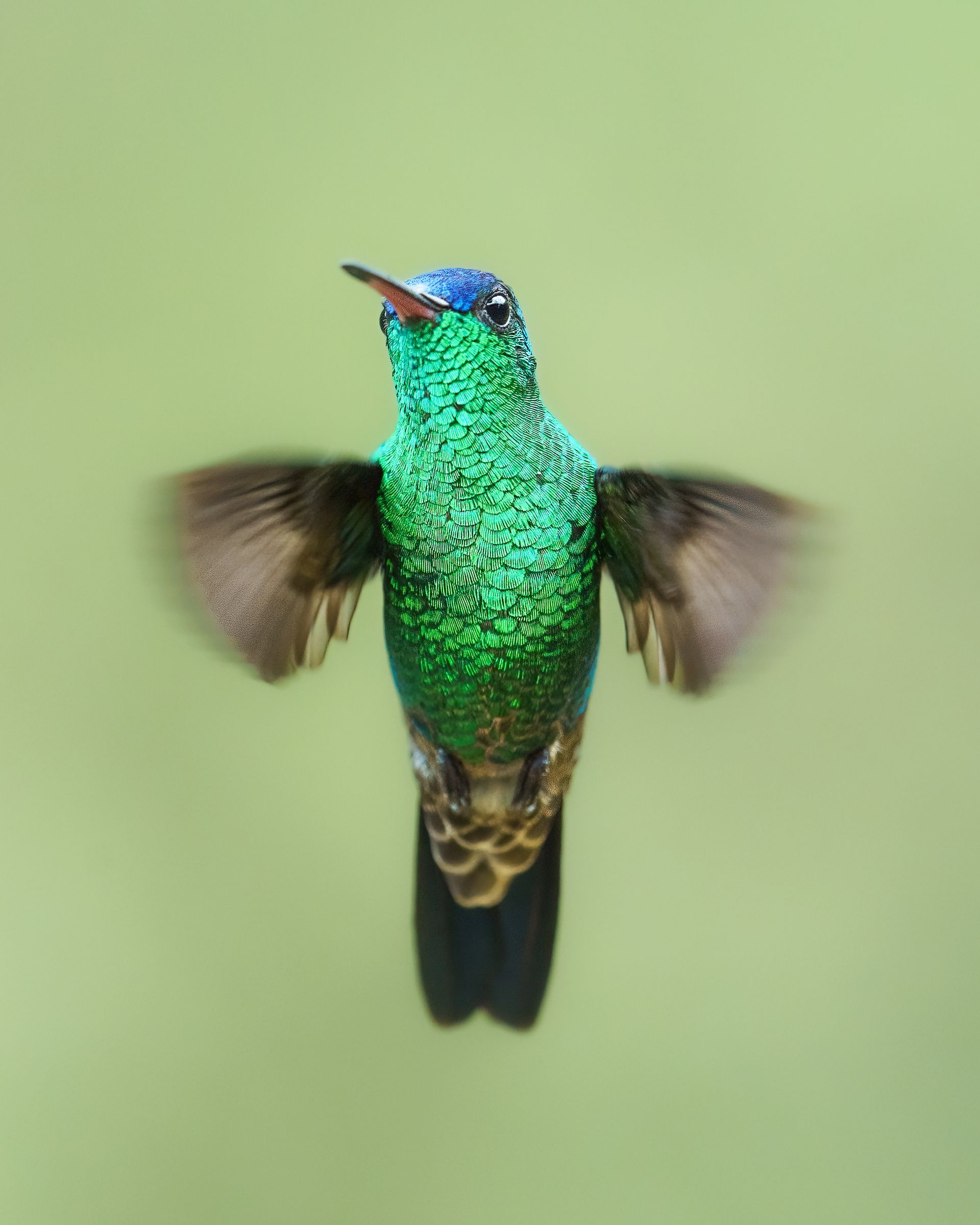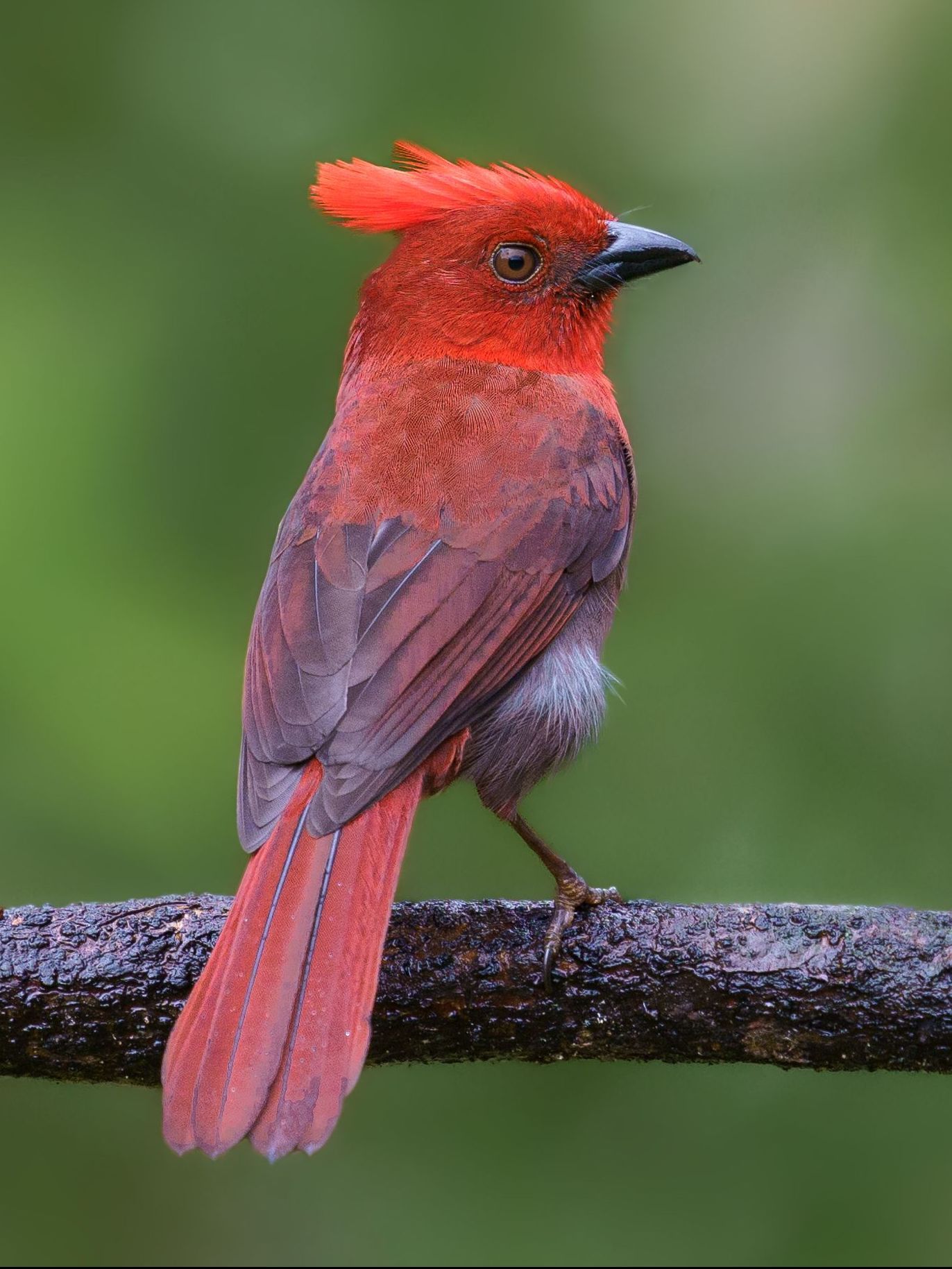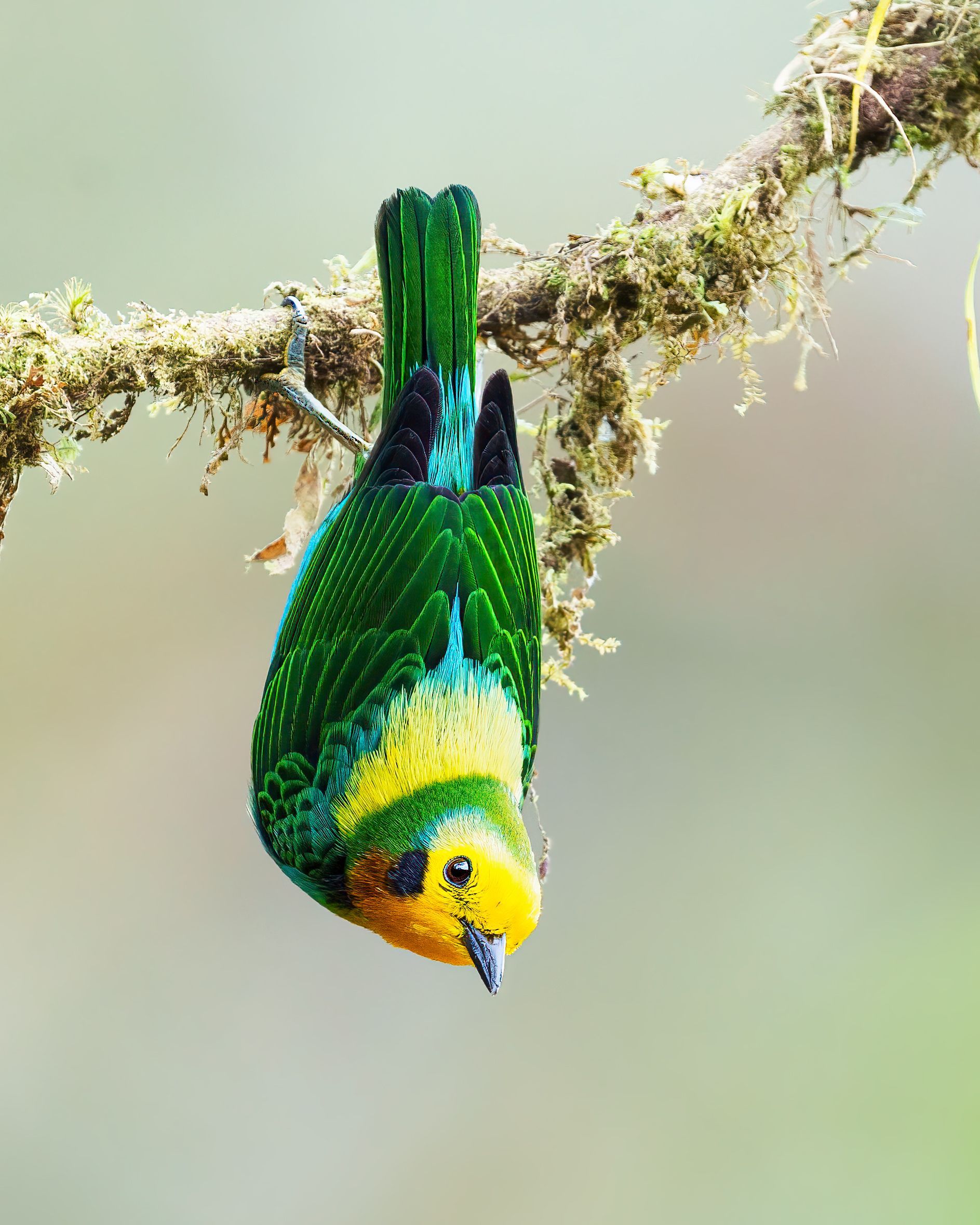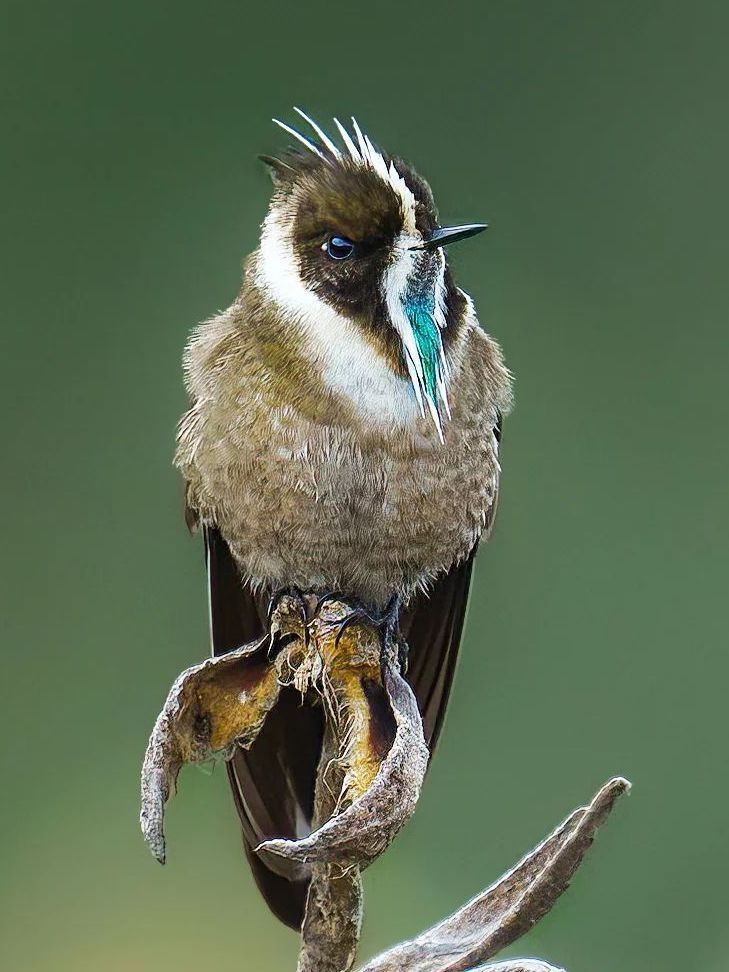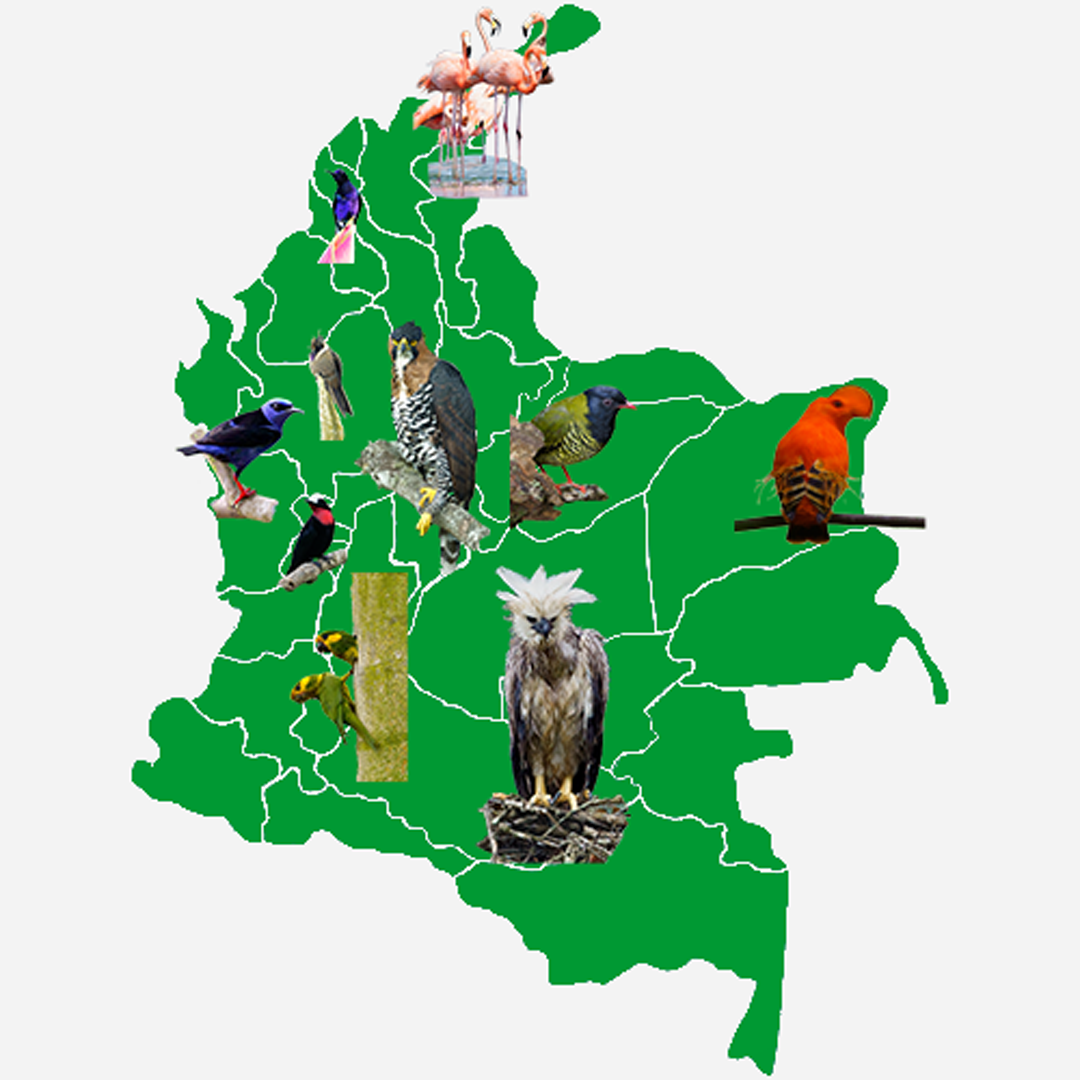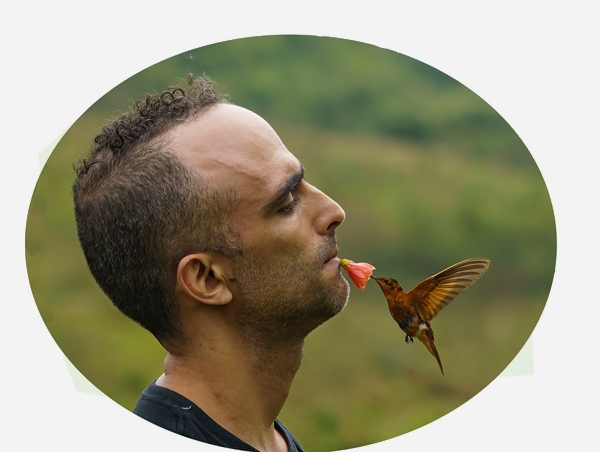Green Bearded Helmetcrest: The Unique Beauty of Colombia's High-Altitude Hummingbird
David Casas • August 5, 2025
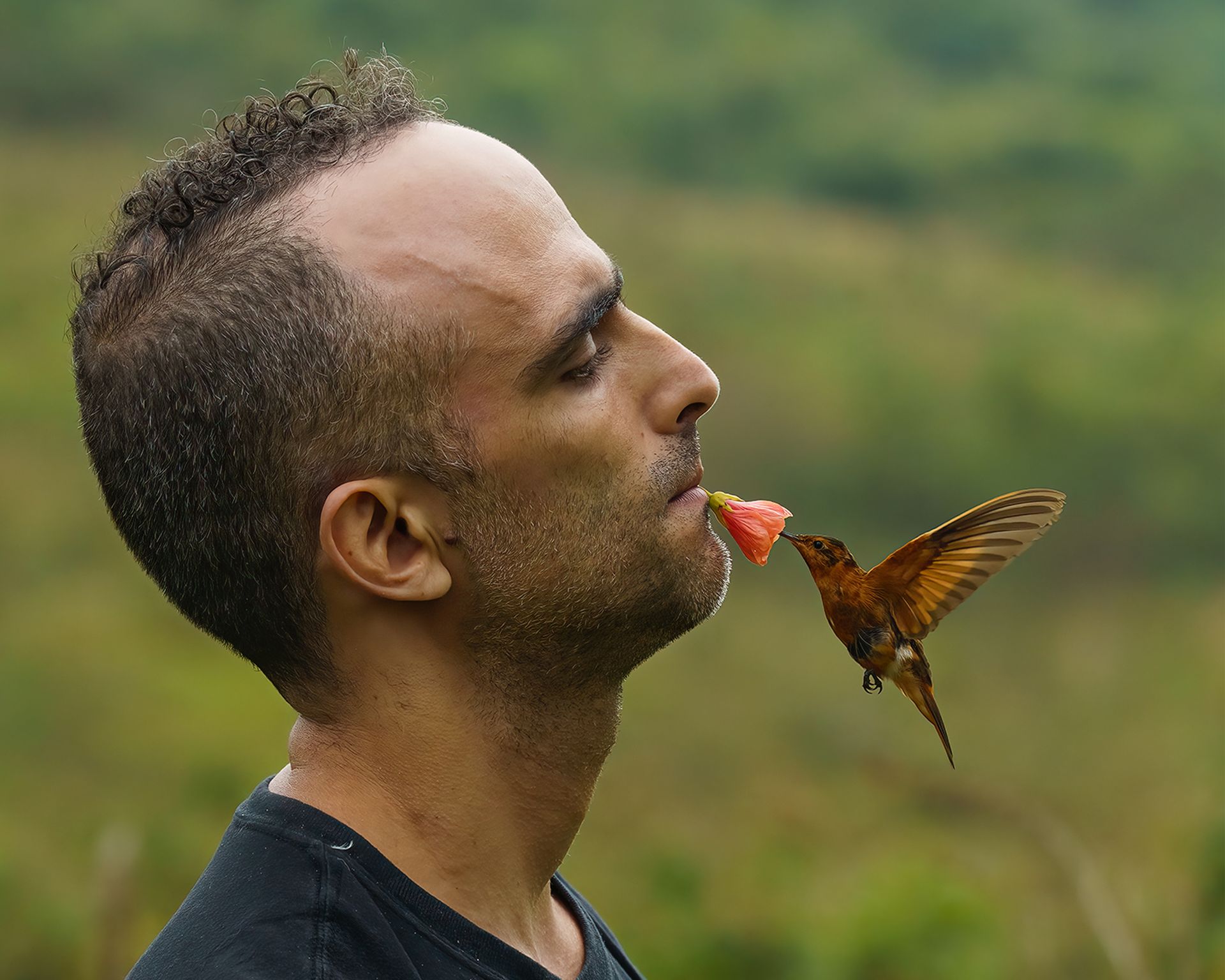
By David Casas
•
August 8, 2025
High in the Andes of Colombia, where mountain mists weave through cloud forests and sunlight spills over rugged ridges, one of nature’s most mesmerizing avian jewels makes its home — the Shining Sunbeam (Aglaeactis cupripennis). Known for its iridescent coppery-gold plumage that glows in direct light, this hummingbird is not just a visual wonder but also a fascinating creature in its behavior, ecological role, and cultural symbolism. The Shining Sunbeam embodies the vibrant biodiversity of Colombia’s montane ecosystems. From the páramo grasslands to the cloud-shrouded forest edges, this bird thrives in a range of high-altitude environments where few other species dare to live. In this article, we’ll explore the appearance, habitat, diet, breeding habits, behavior, and conservation status of the Shining Sunbeam, while also appreciating its unique role in Colombia’s natural heritage. 1. Physical Description: Nature’s Metallic Masterpiece When sunlight catches the feathers of the Shining Sunbeam, it transforms into a living ember in flight. The coppery-gold back and wings are unlike the shimmering greens and blues of most hummingbirds. This distinct coloration is caused by microscopic feather structures that refract light in warm metallic tones, creating a glowing effect in bright conditions. Key features include: Size : Medium for a hummingbird, averaging 11–13 cm in length. Weight : About 6–8 grams , heavier than many smaller hummingbird species. Bill : Straight, medium-length, ideal for probing tubular flowers. Plumage : Primarily bronze to golden-orange on the back, with a slightly paler belly. Tail : Rounded, often with darker tips contrasting against the body’s warmth. Unlike more vividly patterned hummingbirds, the Shining Sunbeam has an almost uniform metallic sheen, making it instantly recognizable in its highland habitat. 2. Distribution and Habitat in Colombia The Shining Sunbeam is found along the Andean slopes , preferring altitudes between 2,400–4,000 meters . In Colombia, it inhabits both the Eastern and Central Andes, with strong populations in Boyacá, Cundinamarca, Antioquia, and Nariño . Its habitats include: Páramo grasslands – Open, treeless ecosystems above the forest line, where flowering shrubs provide year-round nectar. Cloud forest edges – Transitional zones rich in both insect life and floral diversity. Shrublands and disturbed areas – The species adapts well to partially cleared land, as long as nectar sources remain. This adaptability allows the Shining Sunbeam to occupy ecological niches where other hummingbirds might struggle, particularly in colder, windier conditions. 3. Diet and Feeding Behavior Like all hummingbirds, the Shining Sunbeam has a nectar-based diet , supplemented with small insects and spiders for protein. It favors high-altitude flowers, many of which have evolved specifically to attract hummingbirds. Common nectar sources include: Chuquiraga (shrub with orange tubular flowers) Fuchsia boliviana Bomarea species (highland vines with hanging blooms) Feeding Techniques The Shining Sunbeam uses a combination of hover feeding and perch feeding depending on the plant species and weather conditions. In windy páramo zones, perching helps conserve energy while still accessing nectar. Interestingly, this species is also known for territorial defense , fiercely chasing away rivals — even much larger birds — from its feeding grounds. 4. Role in the Ecosystem The Shining Sunbeam plays a vital role in pollination . Many Andean plants depend on hummingbirds for reproduction, and the Sunbeam’s preference for certain flower shapes ensures the transfer of pollen between widely spaced blooms. Because it forages at altitudes where insect pollinators are scarce, its ecological importance is heightened. Without birds like the Shining Sunbeam, some highland plant species would struggle to reproduce, affecting the entire ecosystem’s balance. 5. Breeding and Reproduction Breeding occurs during periods of peak flower availability , which varies by altitude and rainfall patterns. In Colombia’s highlands, this often aligns with December–March and July–September . Nesting Nest Structure : Small cup-shaped nest built with moss, lichens, and spider silk. Nest Location : Often hidden in shrubs or sheltered under overhanging rocks to protect from rain and wind. Eggs : Typically 2 small white eggs. Incubation : Female incubates for about 15–19 days . Fledging : Chicks leave the nest after 20–26 days . The male does not assist in nesting duties, focusing instead on defending feeding territories. 6. Behavior and Temperament The Shining Sunbeam is bold and aggressive for its size. It has been observed chasing off larger species, including flowerpiercers and even other hummingbirds twice its size. Other notable behaviors: Seasonal Altitude Shifts : Some populations move slightly lower during colder months. Sunbathing : Known to perch in sunny spots, spreading its wings slightly — possibly to warm itself or display its plumage. Curiosity toward humans : In areas with regular hikers or birdwatchers, individuals sometimes approach closely, making them a favorite subject for photography. 7. Cultural Significance in Colombia In Colombian folklore, birds with shimmering plumage are often linked to light, vitality, and renewal . While the Shining Sunbeam is less famous than the Andean Condor or Quetzal, among birdwatchers and conservationists it is considered a symbol of the Andean highlands . Local communities sometimes call it “Colibrí Sol” (Sun Hummingbird) due to its glowing, ember-like appearance. 8. Conservation Status and Threats The Shining Sunbeam is currently listed as Least Concern by the IUCN, thanks to its relatively wide distribution and adaptability. However, localized threats exist: Habitat loss from agriculture and grazing in páramo zones. Climate change , which alters flowering patterns and may push suitable habitat higher up the mountains. Pesticide use , reducing insect populations vital for chick rearing. Conservationists stress the importance of protecting páramo ecosystems , which also serve as critical water sources for Colombia’s cities. 9. Birdwatching Tips: How to Spot the Shining Sunbeam If you’re planning to see this species in the wild, consider the following: Best Locations in Colombia : Chingaza National Park, Los Nevados National Natural Park, Sumapaz Páramo. Best Time : Early morning, when flowers open and competition for nectar is at its peak. Equipment : Binoculars with good close-focus ability, or a telephoto lens for photography. Clothing : Warm, layered clothing for high-altitude conditions. Patient observation near nectar-rich shrubs often yields sightings, as the Shining Sunbeam tends to return to the same feeding spots repeatedly. 10. Why the Shining Sunbeam Matters This bird is more than just a pretty sight — it’s an essential thread in the ecological fabric of Colombia’s highlands. Protecting it means safeguarding entire ecosystems that support countless other species, including humans who depend on mountain water sources and pollination networks. Conclusion The Shining Sunbeam is one of Colombia’s most dazzling natural wonders — a creature that combines beauty, resilience, and ecological importance. Its glowing feathers are a reminder of how light and life interact in the world’s high places, where survival demands both strength and grace. By valuing and protecting this bird, we honor not only Colombia’s biodiversity but also the intricate relationships that make our planet’s ecosystems thrive. For birdwatchers, the moment sunlight ignites the Shining Sunbeam’s plumage is unforgettable — a flash of living fire in the cold, thin air of the Andes. SEO Keywords : Shining Sunbeam Colombia, high-altitude hummingbird, Andean hummingbirds, Aglaeactis cupripennis, Colombia birdwatching, páramo wildlife, Colombian birds, iridescent hummingbird, hummingbirds of the Andes, Colombia eco-tourism.
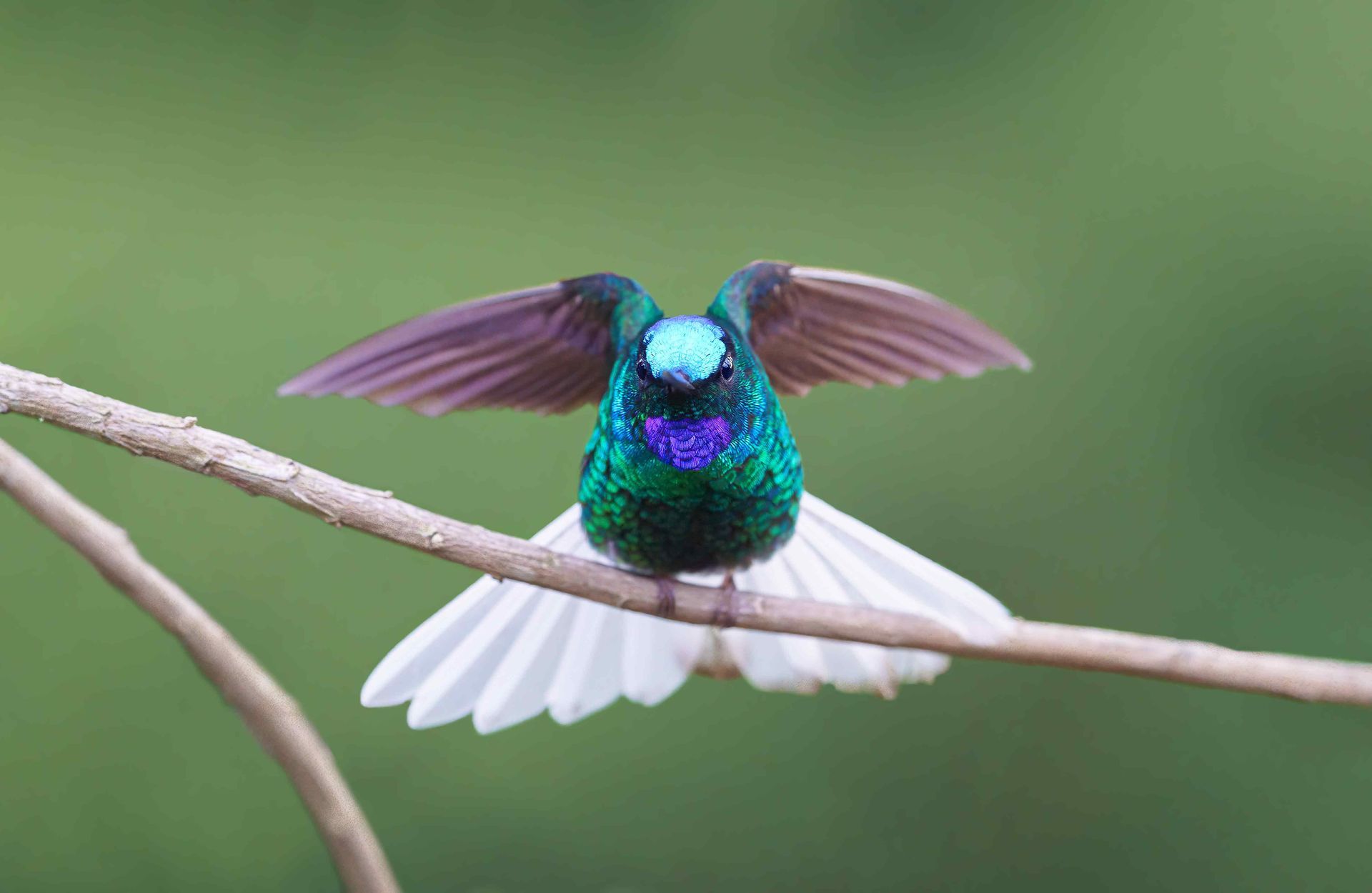
By David Casas
•
August 7, 2025
Colombia, often referred to as the birding capital of the world, is home to an extraordinary diversity of avian species. Among its most dazzling treasures is the White-Tailed Starfrontlet (Coeligena phalerata), a hummingbird that is as rare as it is beautiful. Known for its shimmering colors, graceful movements, and the striking contrast of its pure white tail against iridescent plumage, this species stands out as one of the most elegant nectar drinkers of the Andes. For birdwatchers and nature photographers, spotting the White-Tailed Starfrontlet is an unforgettable moment. Its combination of rarity, beauty, and ecological importance makes it not just a visual delight, but also a symbol of Colombia’s rich biodiversity. Appearance: A Masterpiece of Iridescence The White-Tailed Starfrontlet is a medium-sized hummingbird, typically measuring around 11–13 cm (4.3–5.1 inches) in length. The most distinguishing feature is, as the name suggests, its snow-white tail feathers , which shine brightly even in shaded cloud forests. This white contrasts dramatically with the bird’s metallic green upperparts and brilliant blue throat patch , creating a look that seems almost painted. In good lighting, the plumage reveals an array of shimmering tones: Crown and Back – Metallic emerald green with bronze hints. Throat – Vivid turquoise-blue, often sparkling under sunlight. Underparts – A mixture of green and white, blending into the bright tail. Bill – Long and slightly curved, perfect for reaching deep into tubular flowers. Males and females are similar in appearance, but males typically show more vibrant iridescence and longer tail feathers. Habitat: The Cloud Forest Kingdom The White-Tailed Starfrontlet is endemic to Colombia , meaning it is found nowhere else in the world. It inhabits high-altitude cloud forests , generally between 2,000 and 3,200 meters (6,500–10,500 feet) above sea level. These cloud forests, draped in mist and rich with epiphytes, mosses, and orchids, offer the perfect environment for nectar-rich flowers. The bird is most often seen in the Sierra Nevada de Santa Marta and parts of the Colombian Andes, regions that combine cool temperatures with lush, year-round blooms. Feeding Behavior: Nature’s Nectar Artist Like most hummingbirds, the White-Tailed Starfrontlet feeds primarily on nectar , but it also supplements its diet with small insects and spiders for protein. The bird’s long, slender bill is adapted to feed from tubular flowers, many of which rely on hummingbirds for pollination. Its feeding style is a mesmerizing dance: It hovers gracefully in front of flowers, wings beating up to 70–80 times per second . It inserts its bill deep into the corolla to reach the nectar. Pollen from the flower often dusts its head and throat, which is then transferred to the next bloom—making the bird an important pollinator. In addition to hovering, it sometimes perches on branches or flower stems to conserve energy while feeding. Courtship and Reproduction: A Subtle Romance The breeding season of the White-Tailed Starfrontlet is not well-documented, but observations suggest that courtship involves aerial displays , where males showcase their iridescent plumage in the sunlight, particularly emphasizing the shimmering tail and throat. The female is responsible for building the nest—a small cup made from moss, lichens, and spider silk. She lays two tiny white eggs and incubates them alone. After hatching, the chicks are fed a mixture of nectar and regurgitated insects to support rapid growth. Role in the Ecosystem: More Than Just Beauty While their beauty draws attention, White-Tailed Starfrontlets are also crucial ecological players . They are specialized pollinators for many Andean flowers, particularly species that bloom in colder, higher-elevation environments where insect activity is limited. By transferring pollen between plants, they help maintain the genetic diversity of these floral species, ensuring the continued health of their mountain ecosystem. Threats and Conservation Status Unfortunately, the White-Tailed Starfrontlet faces threats that jeopardize its future: Habitat Loss – Deforestation for agriculture, logging, and infrastructure projects has reduced cloud forest coverage. Climate Change – Shifting weather patterns and rising temperatures are pushing suitable habitats to higher elevations. Fragmentation – Isolated forest patches make it difficult for populations to remain connected. The IUCN currently lists the White-Tailed Starfrontlet as Near Threatened , emphasizing the need for conservation actions to protect both the bird and its habitat. Birdwatching Tips: How to Spot the White-Tailed Starfrontlet For birdwatchers traveling to Colombia, the White-Tailed Starfrontlet is a high-priority target species . Here’s how to improve your chances of spotting it: Best Locations – The Sierra Nevada de Santa Marta and certain Andean reserves in northern Colombia. Time of Day – Early morning and late afternoon are peak feeding times. Flowers to Watch – Look for Passiflora species, Bomarea , and other brightly colored, tubular flowers. Patience – Hummingbirds move quickly; finding the right perch and waiting quietly often yields results. For photographers, using a fast shutter speed and natural light can capture the dazzling iridescence of its plumage. Cultural Significance While not as widely recognized in Colombian folklore as some other birds, the White-Tailed Starfrontlet is increasingly becoming a symbol for ecotourism and biodiversity conservation in the regions where it lives. Its rarity and beauty make it an ambassador for preserving the unique ecosystems of Colombia’s highlands. Conservation Efforts Several Colombian conservation organizations and reserves are working to protect the habitat of the White-Tailed Starfrontlet: ProAves operates reserves in the Sierra Nevada de Santa Marta that safeguard cloud forest ecosystems. Local Communities are involved in sustainable tourism projects that generate income while preserving forests. Reforestation Programs help restore degraded areas to expand the bird’s habitat. Supporting these initiatives through ecotourism or donations directly benefits the species. Final Thoughts The White-Tailed Starfrontlet is more than just a pretty bird—it is a living jewel of Colombia’s mountains, a guardian of highland flowers, and a reminder of the intricate beauty of nature. Its shimmering feathers, rapid movements, and essential ecological role make it a species worth cherishing and protecting. For anyone fortunate enough to see one in the wild, the moment will likely become a treasured memory. In protecting this species, we also safeguard the rich and irreplaceable biodiversity that makes Colombia one of the most remarkable places on Earth.
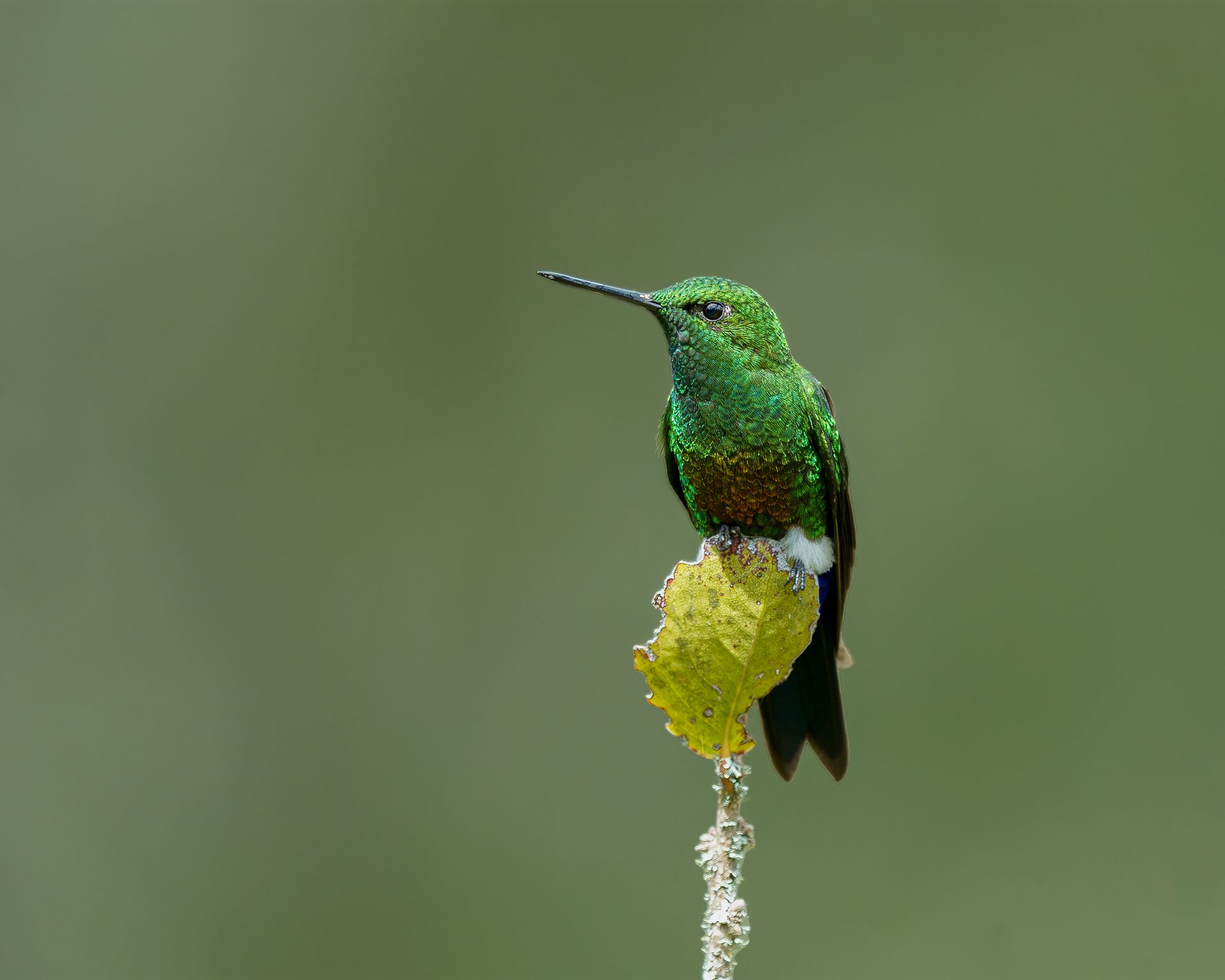
By David Casas
•
August 6, 2025
The Copper-bellied Puffleg (Eriocnemis cupreoventris) is a radiant hummingbird species found in the cloud forests and high-altitude woodlands of Colombia and parts of northern Ecuador. Named for the vibrant copper hues on its underparts and its characteristic fluffy white leg tufts, this bird stands out as one of the most visually captivating jewels of the Andes. With its shimmering plumage and unique ecological adaptations, the Copper-bellied Puffleg is a must-see for bird photographers and nature enthusiasts visiting Colombia's montane ecosystems. Physical Features and Identification Copper-Colored Belly : The standout feature that gives the bird its name, visible under direct sunlight. Puffy White Leg Feathers : These "pufflegs" resemble small cotton balls around the thighs, aiding in insulation. Greenish Head and Back : The iridescent green adds to its overall brilliance. Short, Straight Bill : Ideal for feeding on tubular flowers in its environment. Males tend to have more intense coloration and slightly more pronounced leg puffs compared to females, which are still striking in their own right. Habitat and Range in Colombia The Copper-bellied Puffleg inhabits humid montane forests and forest edges, typically between 2,300 and 3,200 meters above sea level. In Colombia, they are primarily found in: Eastern Andes (Cundinamarca and Boyacá) : Especially in protected reserves and national parks. Chingaza and Sumapaz Regions : Excellent paramo-forest ecotones where the species is relatively accessible. Santander Department : Hosts pockets of ideal highland habitats where pufflegs thrive. Their preference for cloud forests and highland shrubs makes sightings relatively rare but incredibly rewarding. Behavior and Feeding Territoriality : Males often defend prime feeding territories with bursts of aggressive flight. Feeding Strategy : Uses its short bill to probe tubular flowers like Salvia, Fuchsia, and Bomarea. Hovering and Perching : Alternates between hovering like a typical hummingbird and perching quietly, often near flowering plants. Seasonal Movements : Some altitudinal migration may occur depending on flower availability. Their rapid wingbeats and flashes of color through the foliage create striking moments for photographers aiming to freeze their brilliance mid-flight. Photography Tips Capturing the beauty of the Copper-bellied Puffleg in its natural environment requires a blend of skill, timing, and equipment. Recommended Gear: DSLR or Mirrorless Camera with high frame rate and good low-light performance. 300–600mm Lens : Essential for capturing fine details from a distance. Tripod or Monopod : Adds stability in uneven terrain. Flash (optional) : Useful for fill light in darker cloud forest conditions—use ethically. Field Tips: Wait at Flowering Shrubs : Especially those with bright tubular blooms. Use Manual Focus : Autofocus may struggle with dense foliage. Capture Wing Movement : Fast shutter speeds (1/2000 or higher) help freeze wingbeats. Focus on Lighting : The copper hues become most visible under direct or dappled sunlight. Best Time and Locations for Observation Dry Season (December to March) : Offers clearer paths and less rainfall. Morning Hours : Peak activity as birds feed after cool mountain nights. Prime Locations: Reserva Natural Rogitama (Boyacá) El Dorado Reserve (Sierra Nevada foothills) Chingaza National Natural Park Páramo de Guerrero and surrounding cloud forests Conservation and Ethical Observation The Copper-bellied Puffleg is currently listed as Near Threatened , with habitat loss due to deforestation and agriculture being major concerns. Best Practices: Stay on Trails : Avoid damaging undergrowth and native flowers. Avoid Playback : Prevent unnecessary stress to wildlife. Support Eco-Tourism : Choose responsible operators and local guides. Respect Wildlife : Avoid flash photography during feeding or nesting. Role in Ecosystem and Culture As a pollinator , the Copper-bellied Puffleg plays a crucial role in sustaining Andean plant diversity. Its interactions with high-altitude flowers are essential for seed production and forest regeneration. In local folklore and modern eco-tourism circles, the bird is a symbol of fragile beauty —a reminder of Colombia’s unique highland biodiversity and the need for its preservation. Explore with Retorno Photo Tours Retorno Photo Tours offers specialized excursions to Colombia’s cloud forests and paramos, tailored to photographers and birders seeking elusive species like the Copper-bellied Puffleg. Tour Highlights: Private Access to Key Reserves Local Expert Guides with Ornithological Training On-Site Photography Coaching Low-Impact, Conservation-Focused Travel Philosophy Whether you're a seasoned birder or just starting out, our tours provide unforgettable opportunities to witness and capture the vibrant life of Colombia’s highlands. Conclusion The Copper-bellied Puffleg is more than just a beautiful bird—it's a glowing testament to Colombia's rich montane ecosystems and the photographers and conservationists who strive to protect them. With its shimmering colors, charismatic behavior, and highland mystique, this hummingbird offers a bucket-list experience for anyone passionate about nature and wildlife photography. Join Retorno Photo Tours and let the vibrant pulse of the Andes guide your lens toward one of Colombia’s most precious mountain treasures.
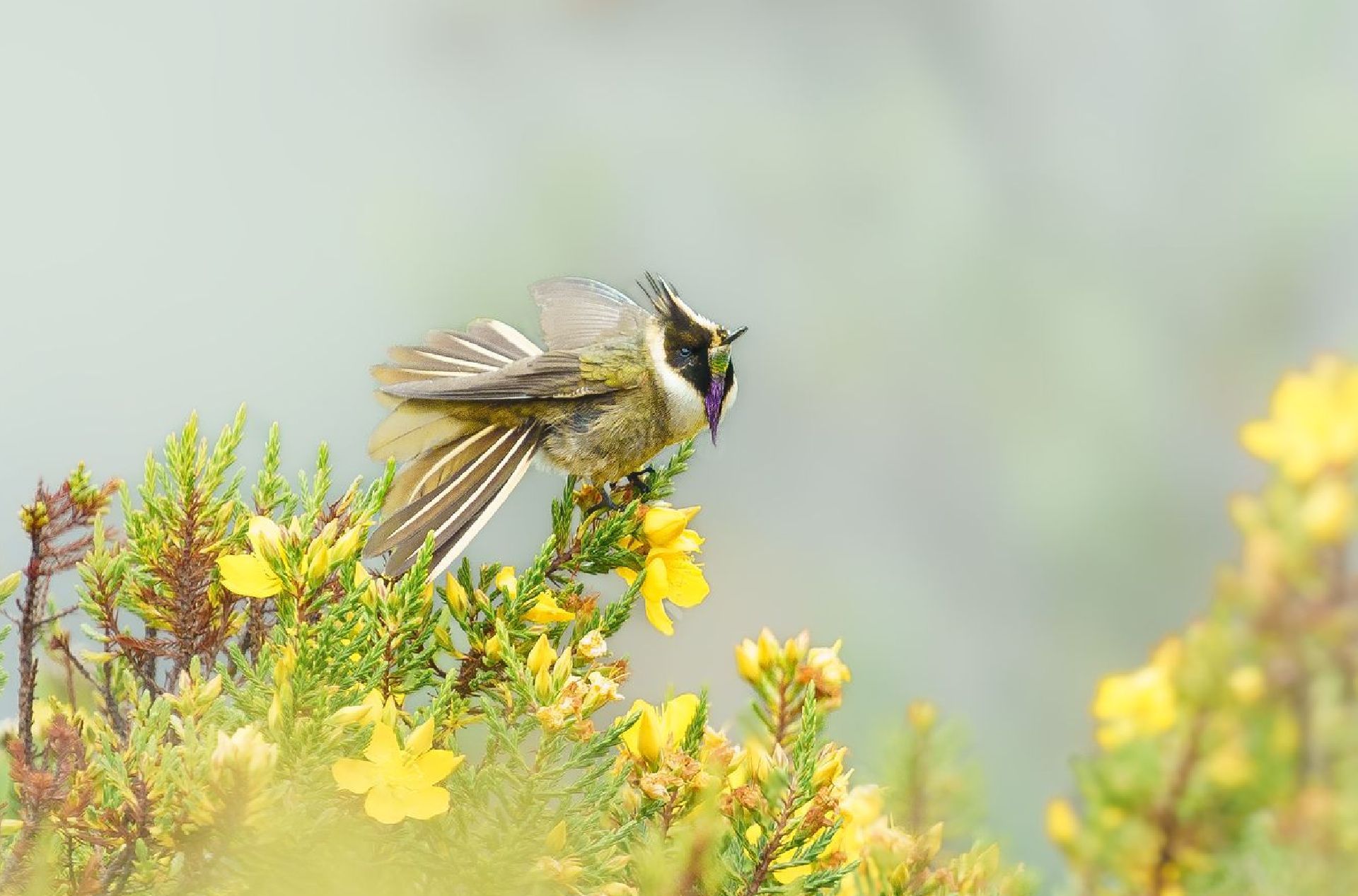
By David Casas
•
August 3, 2025
The Buffy Helmetcrest (Oxypogon stuebelii) is a striking and elusive hummingbird found only in the high-altitude regions of Colombia. Endemic to the Eastern Andes, this species is part of the helmetcrest group, named for their distinctive crown of feathers and whiskered facial tufts. With its buff-colored chest, crested crown, and unique adaptations to paramo life, the Buffy Helmetcrest is a must-see for birdwatchers and a dream subject for wildlife photographers. This bird isn’t just a visual wonder—it also serves as a critical pollinator in one of South America’s most fragile and biologically rich ecosystems. Yet, despite its ecological significance and eye-catching appearance, the Buffy Helmetcrest remains relatively unknown outside specialized ornithological circles. Unique Features of the Buffy Helmetcrest Helmet-like Crest : Both males and females feature a tall crest of feathers, although it is more pronounced in males. Buff-Colored Underparts : A pale buff hue across the chest gives the bird its name and sets it apart from its relatives. White Beard Tufts : These facial features add character and make it easily recognizable. Cold-Climate Specialist : Lives exclusively in high-altitude paramo ecosystems between 3,200 and 4,200 meters. Habitat and Range in Colombia The Buffy Helmetcrest is endemic to Colombia’s Eastern Cordillera , primarily in the departments of Boyacá and Cundinamarca. It thrives in paramo habitats—high, treeless plateaus covered with shrubs, grasses, and flowering plants like Espeletia (frailejones). Key Locations: Nevado del Cocuy National Park : This remote area features ideal habitat and is the best-known location for observing the species. Páramo de Guantiva : Offers additional observation opportunities, though access can be more limited. El Cocuy Basecamps and Trails : Birds can be spotted feeding on native flora near the park’s trekking routes. Because of its restricted range and habitat sensitivity, sightings require strategic planning and good physical fitness due to the extreme altitudes involved. Best Season and Time to Visit Dry Season (December to March) : The clearest skies and driest trails for hiking in the paramo. Early Morning Light : Enhances iridescent feather details and captures the magical glow of the highlands. Peak Flowering of Espeletia : Essential for feeding opportunities and behavior observation. Photography Tips and Gear Photographing the Buffy Helmetcrest involves navigating rugged terrain and dealing with unpredictable weather. Recommended Equipment: DSLR or Mirrorless Camera : Fast autofocus and low-light sensitivity are key. 400mm to 600mm Lens : A long reach helps capture detailed shots without disturbing the bird. Tripod with Gimbal Head : Provides stability on rocky ground. Waterproof Covers : Vital in the moist and windy paramo climate. Extra Batteries : Cold weather drains battery life quickly. Field Techniques: Wait at Known Feeding Plants : Especially Espeletia, the bird's preferred nectar source. Use Natural Cover : Stay behind shrubs or rocks to remain undetected. Adjust for Wind : Use faster shutter speeds to freeze motion in gusty conditions. Capture Environmental Context : Wide-angle shots with frailejones and mist convey the bird’s unique ecosystem. Ethical and Conservation Considerations The Buffy Helmetcrest is listed as Near Threatened due to habitat loss and climate change. Ethical birding practices are essential: No Playback or Disturbance : Allow natural behavior to unfold without interference. Stick to Trails : Prevent trampling of fragile vegetation. Support Local Communities : Use local guides and eco-lodges that contribute to habitat conservation. Minimize Noise and Movement : Paramó species are sensitive to disruption. The Cultural and Ecological Role In local Andean folklore, hummingbirds like the Buffy Helmetcrest are messengers between worlds—symbols of beauty, endurance, and hope. Ecologically, these birds are vital for the pollination of native plants, particularly those adapted to harsh highland conditions. Their survival is tightly linked to the health of the paramo, which is also a major water source for much of Colombia. Protecting the Buffy Helmetcrest means protecting one of the most important ecosystems in the country. Visit with Retorno Photo Tours Retorno Photo Tours provides specialized expeditions to some of Colombia’s most remote and beautiful highland locations. Our custom Buffy Helmetcrest tours include: Expert Naturalist Guides : With field experience in the paramo and bird identification. Physical Prep and Altitude Training : Support and planning for high-elevation photography. Ethical Wildlife Encounters : Prioritizing bird welfare and conservation. Photography Workshops : Tips on composition, gear setup, and low-light shooting. Conclusion The Buffy Helmetcrest is a true emblem of Colombia’s high-altitude wilderness—resilient, rare, and radiant. Whether perched on a flowering frailejón or darting through misty alpine meadows, it offers unforgettable moments for those who venture to see it. With careful planning, ethical practices, and the right guides, photographing the Buffy Helmetcrest can be one of the most rewarding birding experiences in South America. Let Retorno Photo Tours take you to the heart of Colombia’s paramo, where this extraordinary hummingbird reigns amid clouds, wind, and silence.
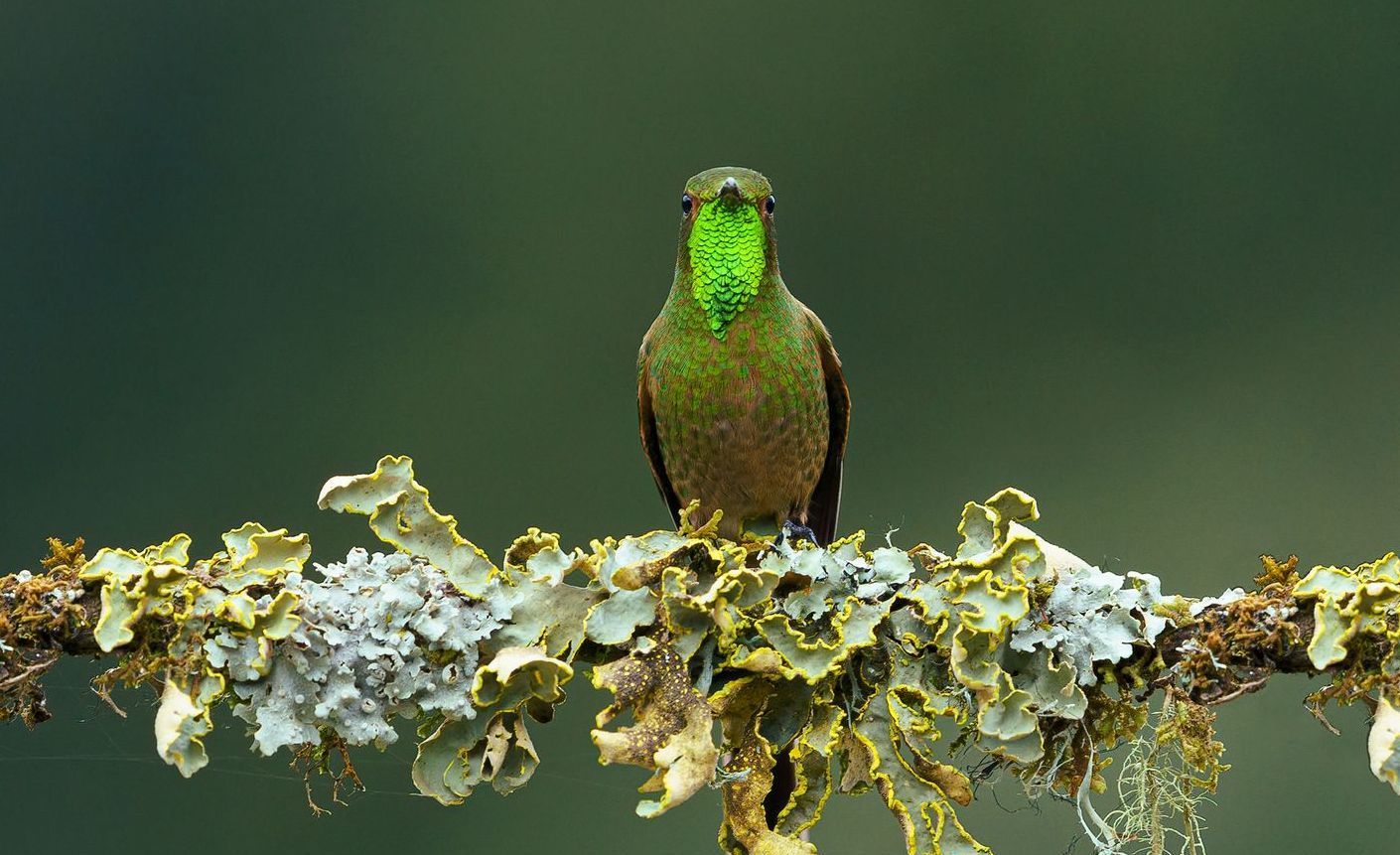
By David Casas
•
August 2, 2025
The Black-tailed Trainbearer (Lesbia victoriae) is one of the most graceful and iconic hummingbirds of the Andean highlands. With its long, flowing tail and emerald plumage, this species glides through the high-elevation landscapes of Colombia, leaving a visual impression as elegant as its name. A favorite among birders and photographers alike, the Black-tailed Trainbearer is a symbol of Colombia's mountainous biodiversity. As a member of the hummingbird family, this avian jewel not only captures attention with its appearance but also plays a vital ecological role. It serves as a pollinator for various native plant species, contributing to the health of Colombia's Andean ecosystems. The Trainbearer's beauty, combined with its ecological importance, makes it an exciting and rewarding subject for nature photographers and conservationists alike. What Makes the Black-Tailed Trainbearer Special Exceptional Physical Traits Long Tail Feathers : Males have elongated, streamer-like tails that can be twice their body length, a characteristic that sets them apart from many other hummingbirds. Iridescent Plumage : Brilliant green feathers shimmer in the sunlight, especially under the crisp light of high-altitude regions. Compact Size : Despite their striking appearance, these birds measure only 12 to 17 cm, with the tail making up much of their length. Behavior and Adaptation Dramatic Display Flights : Males engage in acrobatic courtship displays during breeding season, showcasing their tail feathers in wide, sweeping arcs. High-Altitude Specialist : They thrive in paramo and upper montane scrub between 2,500 and 4,000 meters, well-adapted to thin air and cooler climates. Territorial Nature : Males are highly territorial, aggressively defending their nectar sources from rivals and even other bird species. Prime Locations in Colombia The Black-tailed Trainbearer is widely distributed across Colombia’s Eastern and Central Andes. These birds are typically found in open habitats with scattered shrubs, flowering plants, and light forest edges. Top Spots for Viewing: Chingaza National Natural Park (Cundinamarca) : This park provides ideal páramo conditions with abundant wildflowers and shrubs. Sumapaz National Park : Home to expansive paramo landscapes and well-maintained trails, it offers excellent opportunities to observe these hummingbirds in their natural habitat. Reserva Rogitama (Boyacá) : A private conservation area known for its hummingbird diversity and accessible observation spots. Ocetá Paramo (Monguí) : One of Colombia’s most scenic paramo regions, with consistent sightings of Black-tailed Trainbearers amidst breathtaking terrain. These locations not only offer excellent chances for birdwatching but also provide stunning Andean backdrops, ideal for photographic compositions. Best Time to Visit Bird activity, weather conditions, and lighting all influence the success of a birding or photography expedition. Here are key seasonal considerations: Dry Season (December to March) : Offers easier trail access, clearer skies, and longer periods of ideal lighting for photography. Early Mornings and Late Afternoons : These cooler periods are when hummingbirds are most active, making them the best times for observation and photography. Flowering Season : Align your visit with the blooming cycles of native plants such as Salvia, Puya, and Bomarea, which attract hummingbirds. Recommended Gear Photographing hummingbirds in high-altitude environments requires a combination of lightweight equipment and quick performance. Photography Equipment: Camera Body : High-speed frame rate and fast autofocus are crucial. Full-frame cameras handle low light and detail better. Lens : 300mm to 500mm lenses are ideal. A zoom lens (e.g., 100–400mm) offers versatility, especially when working in tight or unpredictable settings. Tripod or Monopod : Stability is key during long waiting periods; a monopod offers better maneuverability on uneven terrain. Lens Hood and Filters : Help manage sunlight glare at high elevations. Weather Protection : Essential in mountainous terrain where conditions change rapidly. Waterproof covers for both gear and clothing are a must. Tips for Capturing the Trainbearer Success in photographing the Black-tailed Trainbearer comes from combining knowledge of behavior with technical preparation: Focus on the Tail : The trainbearer's long tail is its defining feature. Frame your shots to include the full tail, especially during display flights. Use Backdrops Wisely : Position yourself to capture backgrounds like misty mountains, blooming shrubs, or open skies for dramatic contrast. Wait at Favorite Perches : These hummingbirds often return to the same perch after feeding. Identify one and stay patient. Track Feeding Patterns : Look for clusters of flowers visited repeatedly. Station yourself nearby for action shots. Shoot with Wide Aperture : A shallow depth of field isolates the subject and creates pleasing bokeh effects. Use Silent Shutter Mode : Reduces disturbance and allows for candid behavior shots. Ethical Photography Guidelines Ethical wildlife photography ensures minimal impact on the subject and its environment: Avoid Flash Use : Flash can startle birds, especially during courtship or feeding. Rely on natural light whenever possible. Respect Nesting Zones : Never approach or photograph nests. Disturbing breeding birds can lead to nest abandonment. Support Local Conservation : Choose eco-lodges, local guides, and park services that promote conservation. Leave No Trace : Stick to trails, avoid trampling plants, and carry out all waste. Cultural and Ecological Significance The Black-tailed Trainbearer is more than a photographic subject. In local Andean cultures, hummingbirds are symbols of vitality, agility, and spiritual connection. Some communities view them as messengers or harbingers of good fortune. Ecologically, trainbearers and other hummingbirds serve as critical pollinators, helping maintain the health and reproduction of many Andean plant species. Their presence in paramo ecosystems is also an indicator of environmental quality. A decline in hummingbird populations often signals disruptions in floral cycles, habitat degradation, or climate stress. Explore with Retorno Photo Tours At Retorno Photo Tours , we specialize in creating unforgettable birding and photography experiences in Colombia’s highlands. Why Choose Us? Expert Local Guides : Our team has years of experience tracking hummingbirds in the Andes. Custom Trail Routes : We access remote trails and private reserves that are ideal for trainbearer sightings. Personalized Mentorship : Our guides assist with camera settings, field techniques, and composition to help you get the best shots. Sustainable Practices : We work with local communities and support conservation initiatives with every tour. Our tours aren’t just about photography—they’re about connection. We help you engage with Colombia’s landscapes, wildlife, and culture on a deeper level. Suggested Itinerary Sample Day 1 : Arrival in Bogotá – Meet and greet, orientation, and gear check. Day 2 : Chingaza National Natural Park – Full day of photography with early departure and packed meals. Day 3 : Sumapaz Páramo – Explore remote regions with chances to see multiple paramo species. Day 4 : Transfer to Boyacá – Visit Reserva Rogitama, afternoon garden photography session. Day 5 : Ocetá Páramo – High-elevation adventure with sunrise shoot. Day 6 : Cultural Day – Engage with local artisans and eco-guides. Day 7 : Final shoot and transfer back to Bogotá. Conclusion The Black-tailed Trainbearer is a symbol of the beauty and biodiversity found in Colombia’s Andean trails. From its glowing emerald plumage to the graceful arc of its tail, this bird represents nature’s artistry at its finest. Photographing it in the wild is more than a technical challenge—it’s a rewarding encounter with Colombia’s highland spirit. Whether you're a seasoned wildlife photographer or a birding enthusiast on your first Andean expedition, the Black-tailed Trainbearer promises a memory that will linger long after the shutter clicks. Join Retorno Photo Tours and immerse yourself in Colombia’s mountain majesty—where the air is thin, the flowers bloom bright, and the trainbearer glides like a ribbon of green through the paramo sky.
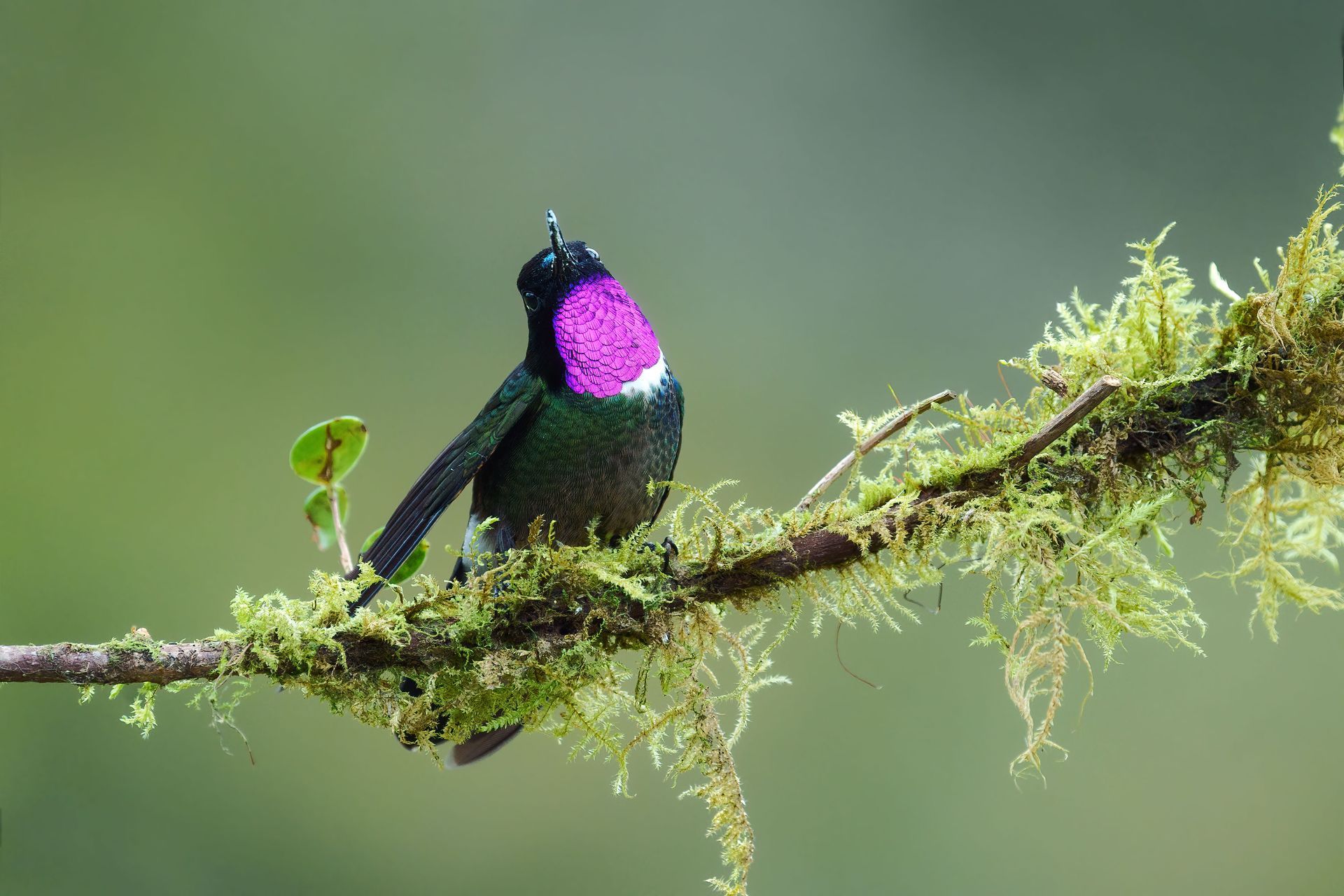
By David Casas
•
August 1, 2025
The Longuemare's Sunangel (Heliangelus clarisse) is a vibrant jewel of Colombia’s high Andean cloud forests. This compact hummingbird dazzles with its iridescent plumage, glowing throat patch, and territorial energy. Endemic to the eastern slopes of the Andes, Longuemare's Sunangel is a bucket-list bird for photographers and a favorite among avid birders seeking radiant color, high-speed flight, and mountain ambiance. Why Longuemare's Sunangel Stands Out Brilliant Iridescence : Males feature a luminous violet gorget and shimmering green upperparts. Highland Specialist : Typically found at elevations from 2,200 to 3,500 meters. Aggressive Feeder : This sunangel fiercely defends flower patches, offering repeated photo opportunities. Endemic to the Northern Andes : A symbol of Colombia’s unique biodiversity. Best Places in Colombia to See Longuemare's Sunangel While this species is found in Venezuela and parts of Colombia, the eastern Andean slope offers the most consistent sightings. Recommended Locations: Santuario de Fauna y Flora Iguaque (Boyacá) : Highland páramo forest with good hummingbird diversity. Observatorio de Aves de Rogitama (Boyacá) : A hummingbird haven with photo-friendly setups. Reserva Natural El Chuscal (Santander) : Offers elevation-appropriate forest and flower patches. Ocetá Paramo (Mongui Region) : Harsh but rewarding habitat with occasional sightings. Local bird guides and eco-lodges in these regions often maintain gardens planted with native nectar-producing plants. Ideal Time to Visit Dry Season (December to March) : Easier trail conditions and more active bird behavior. Early Mornings and Late Afternoons : Best natural light and bird activity windows. Flower Bloom Peaks : Look for native plant flowering patterns in each reserve. Gear Recommendations for Photography This high-altitude hummingbird can be photographed in various settings, from natural habitats to managed gardens. Camera Body : High-speed burst capabilities and excellent ISO range. Lens : 300mm to 500mm lens; macro lens for close feeder shots. Tripod or Gimbal : Ideal for static or framed compositions. Flash (Optional) : Only with diffusers and used ethically. Weatherproofing : Cold and moist conditions require gear protection. Field Tips for Great Shots Identify Feeding Spots : These birds return frequently to favorite perches. Use Continuous Focus : Crucial for tracking rapid movements. Frame with Habitat : Include mossy branches, bromeliads, or páramo flora. Maximize Backlighting : Enhances the glow of the iridescent gorget. Be Still and Quiet : Movement startles even the boldest sunangels. Ethics in Hummingbird Photography Respect Flower Sources : Never pluck or alter natural feeding spots. Avoid Flash at Close Range : Let natural light highlight iridescence. Support Eco-Lodges : Choose places that use sustainable practices. Don't Crowd the Bird : Maintain respectful distance, especially when photographing in gardens or hides. Why Choose Retorno Photo Tours With Retorno Photo Tours , photographing Longuemare's Sunangel is not just about getting a great shot—it’s about the full highland experience. Local Knowledge : Our guides track bloom cycles and bird territories. Premium Access : Private gardens and lesser-known trails for unique perspectives. Support and Training : On-site assistance with settings, composition, and behavior interpretation. Sustainability Commitment : Tours that benefit conservation and local communities. Conclusion The Longuemare's Sunangel is a gleaming ambassador of Colombia’s Andean ecosystem. With the right location, lighting, and patience, you can capture this spectacular nectar feeder in all its iridescent glory. Whether perched on a mossy twig or flashing through mountain mist, it delivers unforgettable moments to the lens. Join Retorno Photo Tours and ascend into Colombia’s highlands—where the sunangel shimmers amid the orchids and clouds.
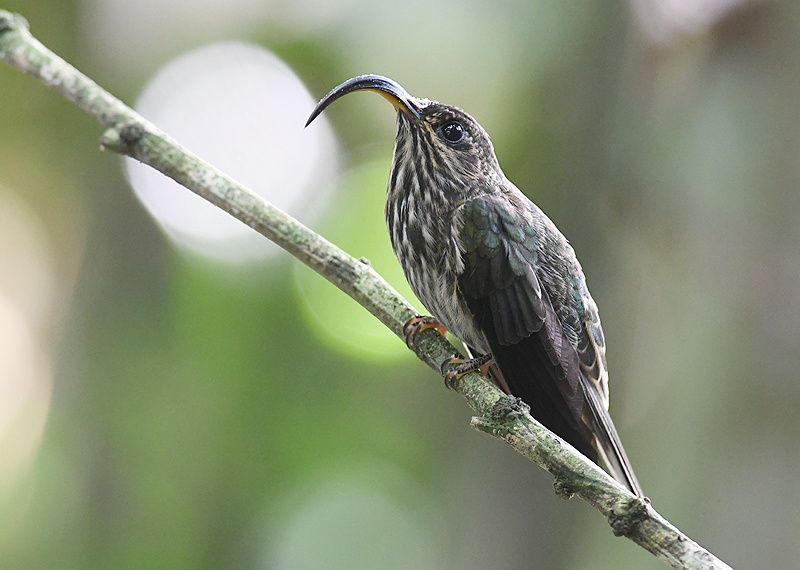
By David Casas
•
July 31, 2025
The White-tipped Sicklebill (Eutoxeres aquila) is a marvel of avian evolution and one of the most unique hummingbirds found in Colombia. Known for its dramatically curved bill, this species is perfectly adapted to feeding on the deep, curved corollas of specific tropical flowers. For birders and photographers, encountering the White-tipped Sicklebill in the wild is a highlight—an opportunity to witness nature's specialization and beauty in motion. Why the White-Tipped Sicklebill Is Special Curved Bill Design : Unlike other hummingbirds, its sickle-shaped bill curves almost 90 degrees, ideal for heliconia flowers. White-Tipped Tail Feathers : A distinct visual trait that gives the bird its name. Elusive Behavior : Often stays hidden in dense understory, darting quickly between flowers. Pollination Role : Plays an important ecological role in tropical forest plant reproduction. Top Locations in Colombia This species favors humid lowland and foothill forests, particularly in regions with abundant flowering plants. Recommended Sites: El Pangán Reserve (Nariño) : One of the best locations for photographing this bird. Parque Nacional Natural Utría (Chocó) : Dense rainforest where heliconias are plentiful. Reserva Natural Tanimboca (Amazonas) : Tropical forest habitat where sightings have been recorded. Amacayacu National Park (Amazonas) : Offers remote forest conditions ideal for this species. These reserves offer lush habitat and are often accompanied by expert local guides familiar with flower hotspots. When to Plan Your Visit Peak Bloom Season (March to May; October to December) : When heliconia and other curved flowers bloom. Early Morning Hours (6:00 AM to 9:00 AM) : Birds are more active and light is softer. After Rainfall : Increased nectar availability brings more hummingbird activity. Best Photography Gear To capture this tiny, fast-moving bird in low-light forest conditions, specific gear is recommended: Camera Body : Fast autofocus, high ISO capabilities, and silent shutter modes. Lens : A 300–600mm telephoto lens with fast aperture (f/2.8–f/5.6). High-Speed Flash (Optional) : When ethically used, can help freeze wing motion. Tripod or Monopod : Helpful for long stints near favorite feeding flowers. Rain Covers : For both gear and yourself; forest humidity is intense. Techniques for Photographing the Sicklebill Wait by Flower Clusters : Locate heliconia patches and wait patiently. Use Burst Mode : Helps capture the fleeting moment when the bird hovers or feeds. Focus on the Eye : As with all bird photography, a sharp eye is essential. Natural Framing : Include flowers or forest elements for environmental storytelling. Use Natural Light When Possible : Let the bird's iridescence shine. Ethical Photography Considerations Avoid Flash Near Nesting Sites : Respect breeding privacy and avoid disturbance. Never Trim Foliage : Allow natural composition and habitat to remain undisturbed. Don’t Use Feeders : The White-tipped Sicklebill prefers specific wild flowers; feeders disrupt behavior. Minimize Noise and Movement : These birds are shy and startle easily. Join Retorno Photo Tours At Retorno Photo Tours , we help nature photographers find and ethically photograph Colombia’s most unique species, including the elusive White-tipped Sicklebill. Our services include: Custom Itineraries : Tailored to find specialty hummingbirds in Colombia’s richest habitats. Local Experts : Our guides know when and where flowers bloom. Comfortable Accommodations : Stay close to action without sacrificing comfort. Hands-On Support : From gear setup to post-processing tips. Conclusion The White-tipped Sicklebill is more than just a hummingbird—it's a testament to the intricate relationships between birds and plants in Colombia's vibrant ecosystems. With its curved elegance and fleeting movements, photographing this species is a rewarding challenge for any serious bird photographer. Join Retorno Photo Tours and explore Colombia’s tropical jungles, where the curved beauty of the Sicklebill awaits amid the petals and shadows of the rainforest.
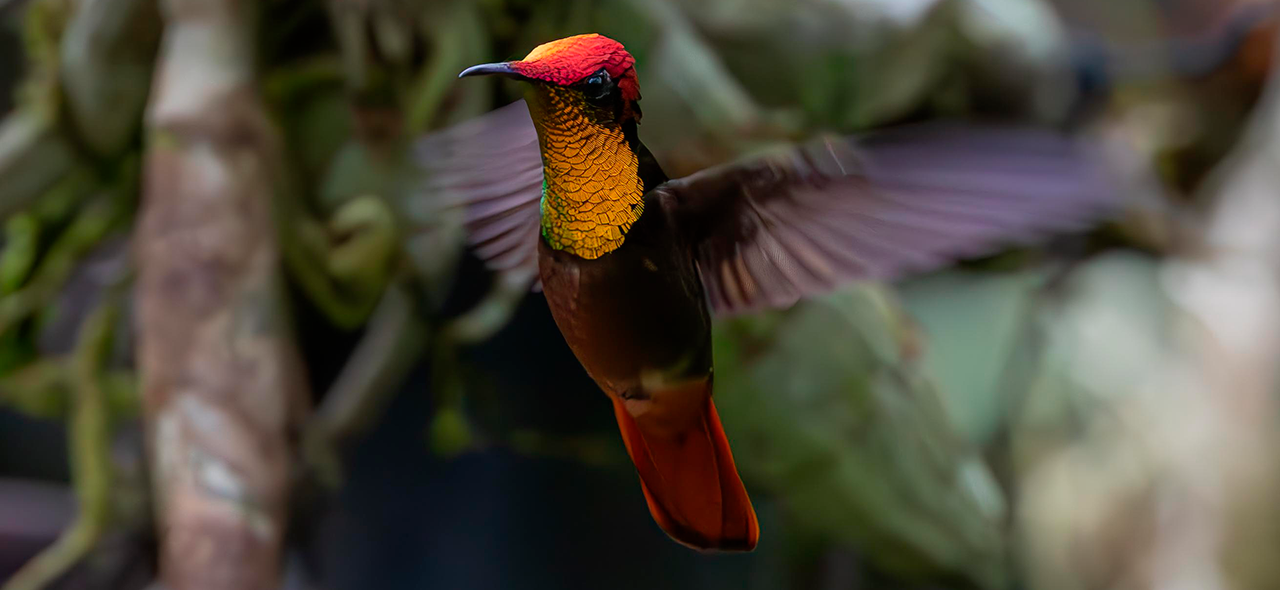
By David Casas
•
July 30, 2025
The Ruby Topaz Hummingbird (Chrysolampis mosquitus) dazzles with iridescent hues and energetic behavior, making it one of Colombia's most striking avian treasures. This vibrant hummingbird, with its brilliant ruby-red crown and fiery golden throat, glitters like a gemstone against tropical backdrops. For bird photographers and enthusiasts alike, the Ruby Topaz offers a perfect combination of color, agility, and spectacle. What Makes the Ruby Topaz So Special Brilliant Coloration : Iridescent ruby and gold feathers make it one of the brightest hummingbirds in South America. High-Speed Acrobatics : Known for its rapid flight and daring aerial displays. Rare in Colombia : Primarily found in the northern lowlands and Caribbean regions. Territorial Behavior : Often aggressively defends feeding spots, giving photographers repeated opportunities. Where to Find Ruby Topaz in Colombia Though more common in the Caribbean and northern South America, Colombia’s coastal regions and certain lowland habitats provide consistent sightings. Key Sites for Spotting: La Guajira Peninsula : Semi-arid zones where flowering trees attract this species. Tayrona National Natural Park : Coastal tropical forest home to numerous nectar plants. Santuario de Flora y Fauna Los Flamencos : Though known for flamingos, this site also hosts nectar-rich zones. Sierra Nevada Foothills : Lower elevations offer occasional sightings near forest edges and gardens. Partnering with local birding guides in these areas significantly boosts your chances of an encounter. Ideal Time to Visit Dry Season (December to April) : Fewer rain disruptions and peak blooming season. Early Mornings (6:00 AM to 8:30 AM) : Ruby Topaz are most active during the cool morning light. During Nectar Surges : Track regional flowering cycles for optimal sightings. Recommended Camera Equipment Capturing the sparkle and speed of the Ruby Topaz requires precise gear: Camera Body : High burst rate, fast autofocus, and excellent ISO range. Lens : A 300mm to 600mm lens; image stabilization is a plus. Flash (Optional) : Use ethically to highlight iridescence but avoid nesting areas. Tripod or Gimbal Head : Useful for static shots near known feeding perches. Weather Covers : Coastal climates can be humid and unpredictable. Field Techniques for Stunning Shots Focus on Perches : Ruby Topaz often returns to the same branches. Use Burst Mode : Essential for freezing rapid wingbeats or courtship flights. Play with Angles : Iridescence shines differently based on light direction. Natural Framing : Incorporate tropical blooms or blurred background leaves for visual richness. Wait Patiently : Pick a spot near a flowering tree and let the bird come to you. Ethical Bird Photography Tips Avoid Overuse of Flash : Especially near breeding territories. Don’t Use Artificial Feeders : Let the bird engage naturally with wild flora. Stay Hidden and Quiet : Sudden movement scares hummingbirds easily. Respect Flora : Don’t damage plants to get a better angle. Experience It with Retorno Photo Tours At Retorno Photo Tours , we offer immersive, eco-conscious bird photography experiences focused on Colombia’s rarest and most colorful species, including the Ruby Topaz. Our tours feature: Expert Regional Guides : Deep local knowledge of blooming cycles and territories. Curated Routes : Designed to maximize hummingbird sightings. Flexible Schedules : Prioritize light conditions and bird behavior. Ethical Focus : We partner with communities and reserves that protect native habitats. Conclusion The Ruby Topaz Hummingbird is a fiery jewel that brings light and magic to Colombia’s lowland tropics. Whether silhouetted in flight or glowing in a shaft of morning sun, this hummingbird is a dream subject for photographers seeking vivid detail and natural spectacle. Join Retorno Photo Tours to explore the most vibrant corners of Colombia, where the Ruby Topaz blazes through the flowers like a living flame.
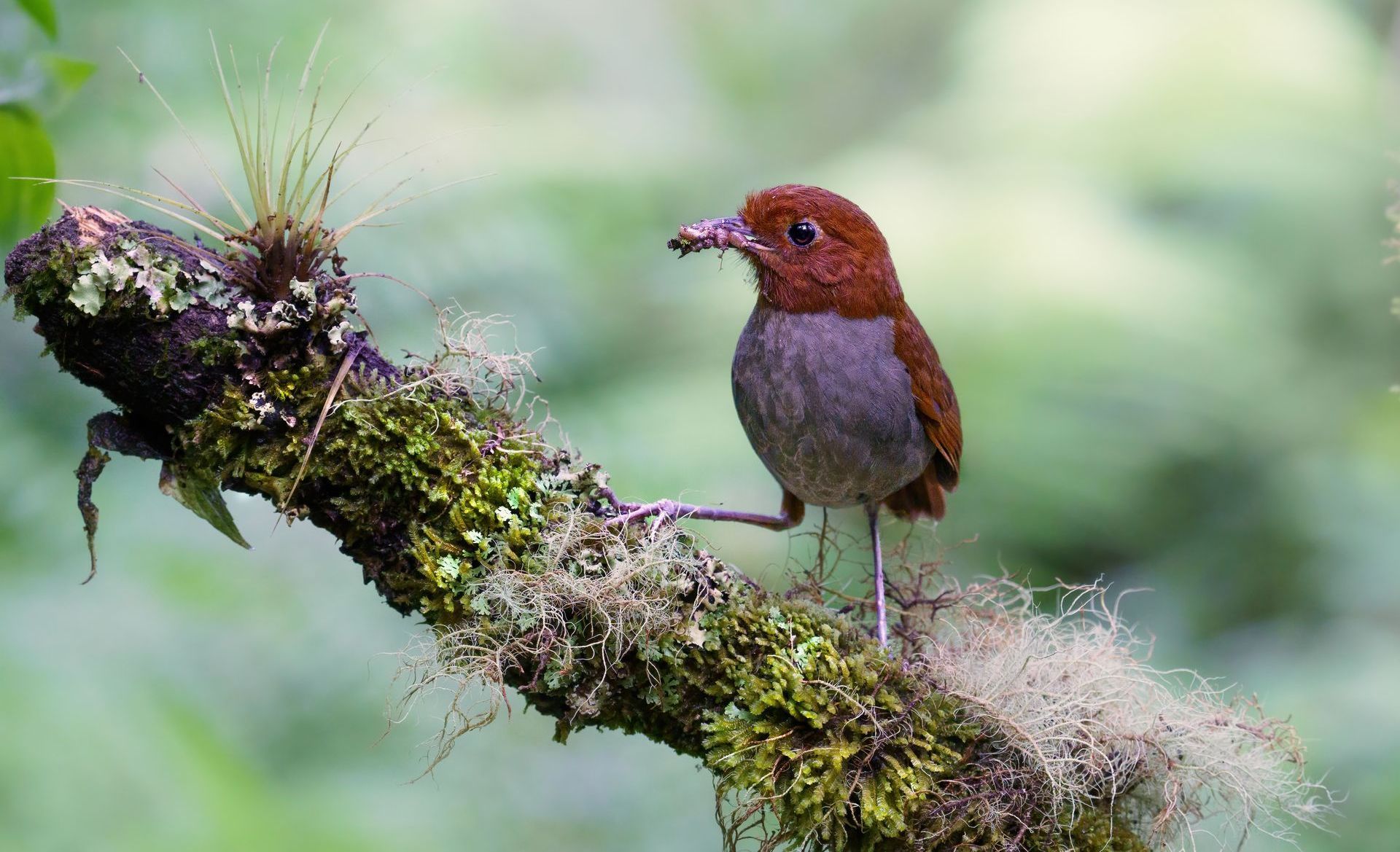
By David Casas
•
July 29, 2025
The Bicolored Antpitta (Grallaria rufocinerea) is a rare jewel of Colombia’s misty montane forests. With its striking two-tone plumage and elusive nature, this endemic bird presents an irresistible challenge for bird photographers and nature lovers. Found only in select areas of the Central Andes, the Bicolored Antpitta is not just a photographic subject but a conservation symbol representing the fragile richness of Colombia’s biodiversity. Why the Bicolored Antpitta Stands Out Endemic to Colombia : Found only in a narrow elevation band in the central Andean range. Conservation Priority : Classified as vulnerable due to habitat loss and fragmentation. Striking Appearance : Deep chestnut upperparts contrast with its gray underparts, making it a visual standout on the forest floor. Distinctive Call : A resonant, mournful note often heard at dawn. Best Locations to Photograph the Bicolored Antpitta This antpitta is highly range-restricted but can be reliably observed in a few protected areas: Reserva Rio Blanco (Manizales) : Known for active feeding stations where the species often appears. Tinamú Birding Reserve (Caldas) : Some trails occasionally produce sightings. La Romelia Reserve (near Manizales) : Offers increasing photographic opportunities thanks to focused conservation efforts. Local guides at these reserves are crucial—they know the birds' territories and behaviors, dramatically increasing your chances. Ideal Season and Time of Day Dry Season (December to March) : Less rain makes trails easier to navigate and improves lighting. Early Mornings (5:30 AM to 9:00 AM) : The bird is most active during dawn hours. Feeding Station Timing : Some reserves use conservation-approved feeders where birds arrive predictably. Recommended Gear for Bicolored Antpitta Photography Capturing clean, emotive images of this elusive bird requires careful preparation: Camera Body : Fast autofocus, good ISO performance in low light. Lens : 300–600mm telephoto lens; a 100–400mm works well for feeding station shots. Tripod or Bean Bag : Stability is essential in dim light conditions. Camouflage Gear : Helps minimize visibility and disturbance. Rain Gear : Always carry protection for your equipment and yourself. Techniques for Success in the Field Use a Hide or Stay Low : Some stations provide shelters; otherwise, crouch quietly. Focus on the Eye : Sharp eye detail is key to a successful bird portrait. Watch for Behavior : Look for tail flicks, head tilts, and feeding behavior to capture expressive moments. Minimize Movement : This shy species spooks easily. Use Silent Shutter Modes : Keeps your presence unobtrusive. Ethics and Conservation Practices Support Ethical Feeders : Only photograph at feeding stations managed for conservation and research. Limit Playback : Avoid disrupting bird behavior, especially in breeding seasons. Respect Boundaries : Follow reserve guidelines and do not stray from designated trails. Educate and Advocate : Share your images to raise awareness of this species' vulnerable status. The Retorno Photo Tours Advantage At Retorno Photo Tours , we offer specialized itineraries designed to photograph Colombia’s most elusive birds, including the Bicolored Antpitta. Our advantages include: Expert Local Knowledge : Our guides track known territories and update sightings daily. Private Access and Permits : We work with reserves that provide early access and limited visitor numbers. On-Site Coaching : Our team assists with camera settings and best practices in the field. Conservation-Focused Approach : Every tour supports habitat protection and local communities. Conclusion Photographing the Bicolored Antpitta is more than a bucket-list experience—it's a rare chance to document a species that few people have seen, let alone photographed. With patience, ethical practices, and expert guidance, you can return home with not only incredible images but a deeper appreciation for Colombia’s unique and fragile mountain ecosystems. Let Retorno Photo Tours take you deep into the Andean cloud forest to meet one of Colombia’s most captivating forest residents—one frame at a time.



